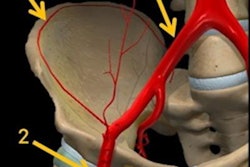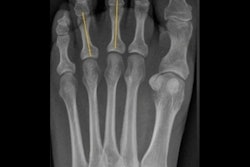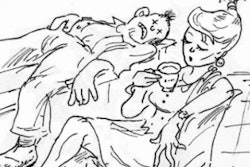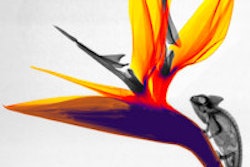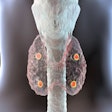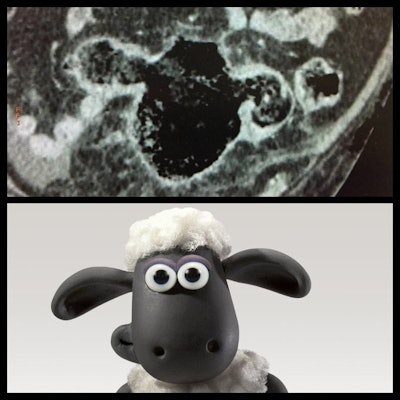
Keeping in mind movie characters like Darth Vader, Davy Jones, and Shaun the Sheep can boost fun and productivity in radiology reporting and be a useful training tool, say Spanish radiologists. They've studied pareidolia -- a form of pattern recognition in which an image looks like an object or a creature -- and they've shared 11 examples for you to savor.
"It's important to see beyond anatomical structures and diagnostic radiology in our daily practice. Let your imagination fly and enjoy an alternative view of common images," said Dr. Yasmín El Khatib Ghzal, from the radiology department at University Hospital of the Nuestra Señora de Candelaria, Santa Cruz de Tenerife, and colleagues.
Open your eyes and try to see beyond echogenicity, opacity, density, and signal intensity, they added.
 Neck Vader. Neck CT (axial) of anterior cervical region looks like Darth Vader (Star Wars). All figures courtesy of Dr. Yasmín El Khatib Ghzal, ECR 2021, and @radiologypareidolia.
Neck Vader. Neck CT (axial) of anterior cervical region looks like Darth Vader (Star Wars). All figures courtesy of Dr. Yasmín El Khatib Ghzal, ECR 2021, and @radiologypareidolia.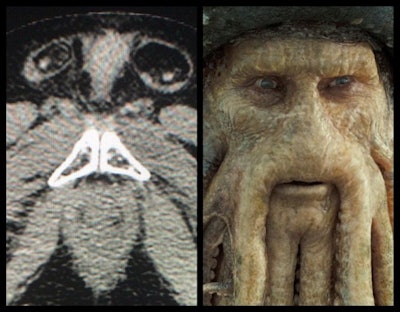 Davy Jones pelvis. Pelvic CT (axial) of pubis, inguinal canals looks like Davy Jones (Pirates of the Caribbean).
Davy Jones pelvis. Pelvic CT (axial) of pubis, inguinal canals looks like Davy Jones (Pirates of the Caribbean).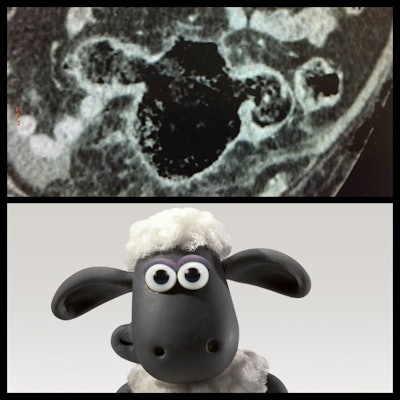 Shaun the Sheep diverticula. Abdominal CT (axial) and giant colonic diverticula looks like Shaun the Sheep.
Shaun the Sheep diverticula. Abdominal CT (axial) and giant colonic diverticula looks like Shaun the Sheep.Pareidolia made simple
Pareidolia is the tendency to interpret a vague stimulus as something known to the observer, such as seeing shapes in clouds or seeing faces in inanimate objects or abstract patterns, and it's not a new phenomenon, the authors explained.
"Leonardo da Vinci described seeing characters in natural markings on stone walls, which he believed could help inspire his artworks. In the 1950s, the Bank of Canada had to withdraw a series of banknotes because a grinning devil leaped from the random curls of the Queen's hair. The Viking I spacecraft, meanwhile, appeared to resemble a carved face in the rocky landscape of Mars," they wrote in an ECR 2021 e-poster that received a certificate of merit.
This phenomenon also applies to the interpretation of radiological images, according to El Khatib Ghzal and colleagues.
Metaphoric signs in radiology have been used for over 100 years, and these associations allow radiologists to recognize and remember the imaging patterns of disease by the names they have given to them, such as the apple-core sign in colon cancer, the onion skin periosteal reaction in aggressive periostitis, the bird's beak sign in achalasia, or the bear's paw sign in xanthogranulomatous pyelonephritis.
"But what happens when we see random look-alikes during our working day?" Ghzal et al asked. "The result is an unexpectedly amusing interpretation of normal and abnormal imaging findings, mainly for entertainment purposes."
Below is a selection of eight more radiological pareidolias the authors have encountered on images from their institution.
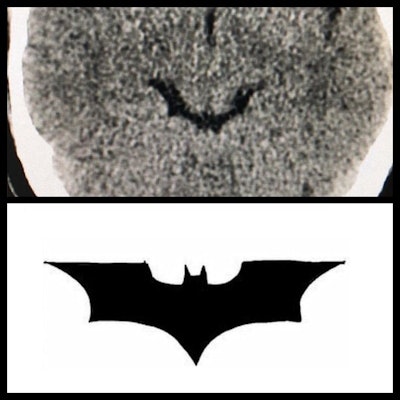 Batman quadrigeminal cistern. A brain CT (axial) of normal quadrigeminal cistern looks like the Batman logo.
Batman quadrigeminal cistern. A brain CT (axial) of normal quadrigeminal cistern looks like the Batman logo.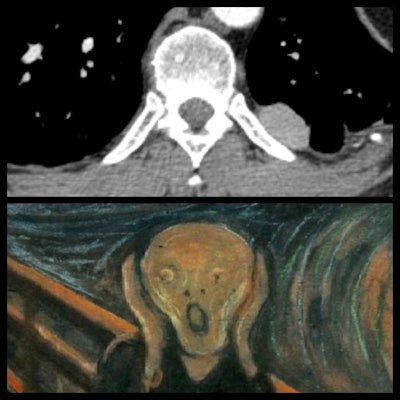 The vertebral scream. Chest CT (axial) of normal vertebra, spinal canal, and posterior ribs looks like the Scream by Edvard Munch.
The vertebral scream. Chest CT (axial) of normal vertebra, spinal canal, and posterior ribs looks like the Scream by Edvard Munch.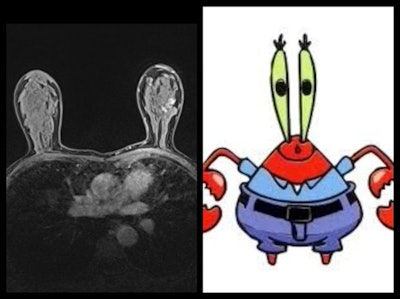 Breast crab. Breast MRI (axial) of breasts and thoracic cavity looks like Mr. Krabs, a character in the U.S. animated TV series SpongeBob SquarePants.
Breast crab. Breast MRI (axial) of breasts and thoracic cavity looks like Mr. Krabs, a character in the U.S. animated TV series SpongeBob SquarePants.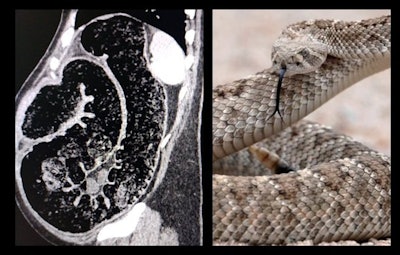 Colonic snake. Abdominal CT (sagittal) of large bowel obstruction looks like a snake.
Colonic snake. Abdominal CT (sagittal) of large bowel obstruction looks like a snake.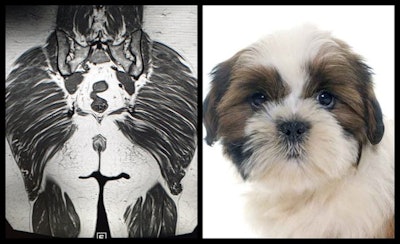 Gluteal dog. Pelvic MRI (coronal) of gluteal muscles looks like a dog.
Gluteal dog. Pelvic MRI (coronal) of gluteal muscles looks like a dog.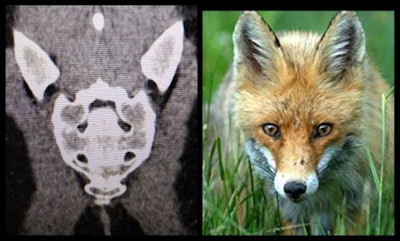 Sacral fox. Pelvic CT (coronal) of sacral bone and ilium looks like a fox.
Sacral fox. Pelvic CT (coronal) of sacral bone and ilium looks like a fox.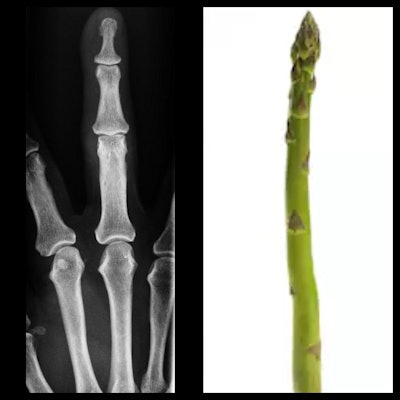 Asparagus finger. X-ray of finger, phalanx looks like an asparagus tip.
Asparagus finger. X-ray of finger, phalanx looks like an asparagus tip.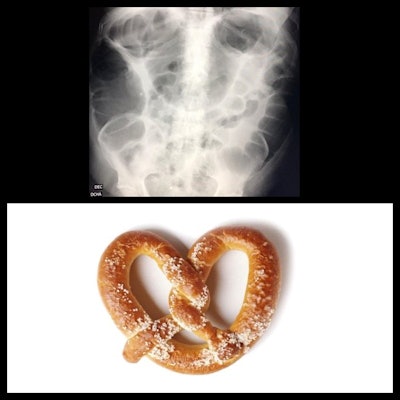 Colonic pretzel. Abdominal x-ray of colon looks like a pretzel.
Colonic pretzel. Abdominal x-ray of colon looks like a pretzel.In creating their e-poster, the authors said they were influenced by the work of radiologist Dr. Brian Gibney and his colleagues at Mater Misericordiae University Hospital, Dublin (see Pareidolia in Radiology Education: A Randomized Controlled Trial of Metaphoric Signs in Medical Student Teaching, Acad Radiol, 17 September 2020). Also, you can go to @radiologypareidolia on social media.
Editor's note: The number of the ECR e-poster is C-11608, and you can access it via the EPOS database on the European Society of Radiology website.




